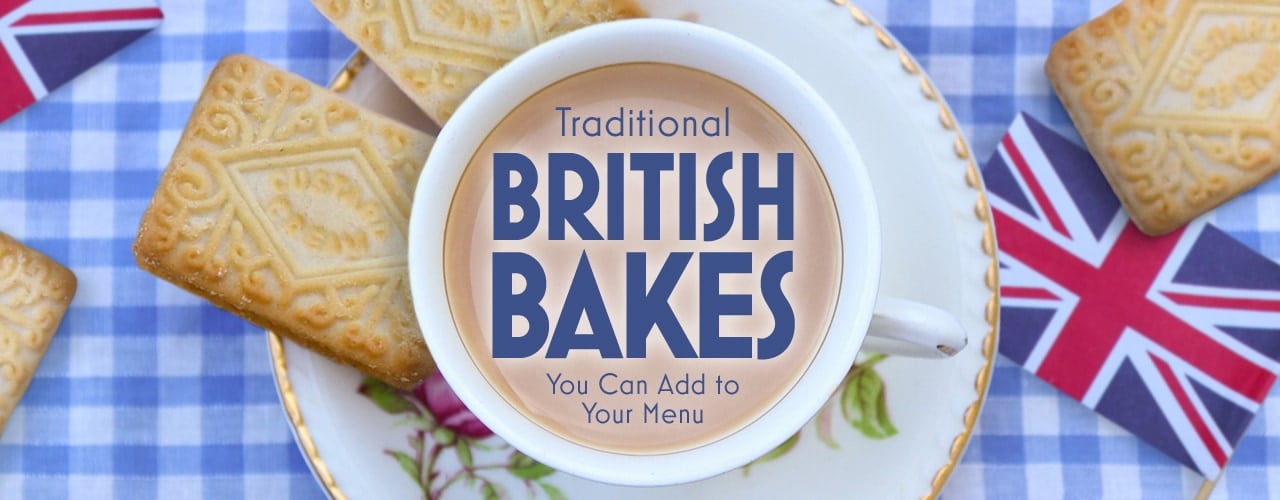British Desserts You Can Add to Your Menu
Last updated on Sep 17, 2025Michale LeRoyThere’s a lot to be said for American bakery classics like the humble jelly donut or the beloved chocolate chip cookie, but there’s a world of bakery items out there waiting to be discovered. Thanks to the popularity of the TV show The Great British Bake Off, or The Great British Baking Show as it’s known in the States, Americans are now being exposed to traditional British desserts.
Have you ever wanted to add classic British bakery items to your dessert menu or bakery case? Whether you’re opening a new bakery or revamping your current offerings, read on to learn about some of the most popular Great British Baking Show recipes and how you can incorporate them into your menu.
Desserts From the Great British Baking Show
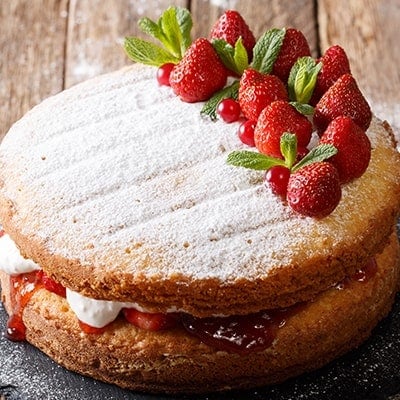
We've made a list of the most iconic British bakes from your favorite show:
1. Victoria Sponge Cake
The Victoria Sponge sandwich cake is the quintessential British dessert. It consists of a layer of whipped double cream and a layer of raspberry or strawberry jam, sandwiched between two feather-light vanilla cakes.
In order to bake the perfect sponge, you must ensure that the cake mixture is light and full of air. To retain air in your batter, use room temperature ingredients and fresh eggs. Make sure to sift your dry ingredients and don't overmix the batter.
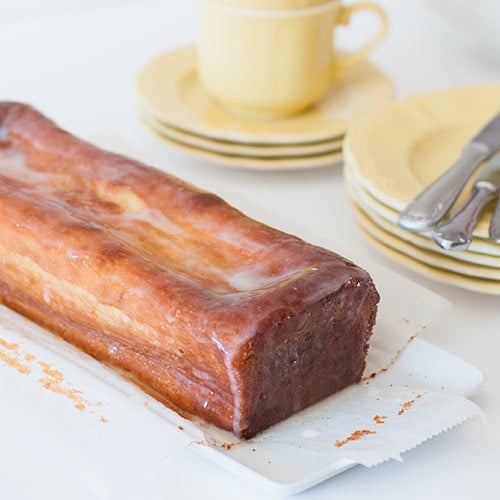
2. Lemon Drizzle Cake
A British tea time favorite, lemon drizzle cake doesn’t take a lot of time to prepare, so it’s a great dessert for beginners to test their baking skills. First bake a lemon sponge in a lined loaf bread tin. Then, while the cake is still warm, prick the surface all over with a fork.
Drizzle a mixture of caster sugar and fresh lemon juice all over the top of the cake. The glaze moistens the cake and forms a crunchy topping as it cools. This lemony-sweet cake will keep in an airtight container for 3-4 days.

3. Chelsea Buns
The Chelsea bun is made with yeasted dough and shaped into a swirl pattern, which makes it look very similar to a cinnamon bun. A major difference between the two is that the Chelsea bun gets a generous helping of dried fruit like currants, raisins, apples, or apricots before the dough is rolled and cut into individual buns. The key to fluffy buns is to let the dough rise once after kneading and a second time after shaping.
Chelsea buns were considered a hot item when they were invented by the Chelsea Bun House in the early 1700s.This traditional spiced fruit bun has seen a resurgence thanks to being highlighted on the Great British Baking Show.
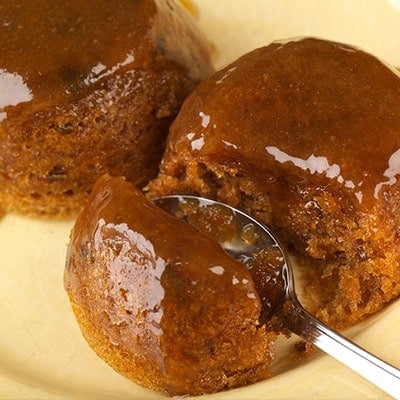
4. Sticky Toffee Pudding
This classic British dessert consists of a dense cake made with dates and drenched in a rich toffee sauce, usually served with cream or custard. Traditional recipes call for Demerara sugar, a partially-raw brown sugar with large crystals and a subtle molasses flavor.
If you don’t have Demerara on hand, you can substitute Turbinado or light brown sugar. Use a muffin pan to produce single servings of pudding for your guests.
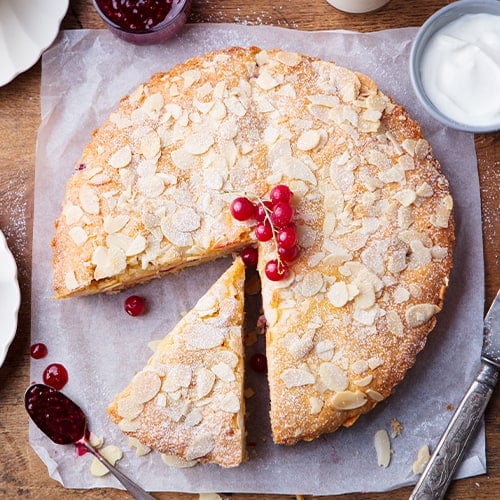
5. Bakewell Tarts
There is some debate over how to make the perfect Bakewell tart. Should it be iced or not? The traditional Bakewell tart begins with a shortcrust pastry shell, a layer of jam, followed by frangipane filling. It’s then sprinkled with flaked almonds and a dusting of confectioner’s sugar. The addition of icing and a candied cherry changes the dessert from a traditional Bakewell tart into a Cherry Bakewell, according to supporters of the traditional recipe.
Fans of the Great British Baking Show may remember the infamous episode where contestants were tasked with making a Bakewell Tart topped with icing instead of almonds. Former host, Mary Berry, makes her version of the tart with feathered icing for a unique presentation.
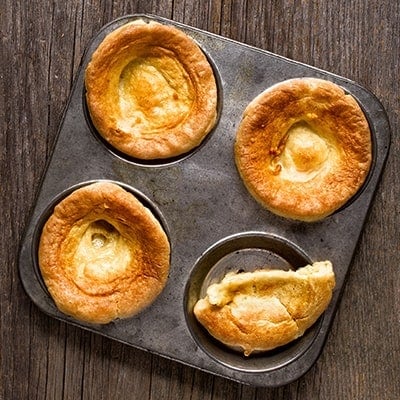
6. Yorkshire Pudding
Possibly one of the most mysterious British baked goods, Yorkshire puddings are neither a pudding or a dessert. The signature “Yorkie” is a puffy roll with a cup-like shape, perfect for holding gravy. It’s usually served alongside a dinner of roast beef.
There are many theories about how best to achieve the signature shape of the Yorkshire pudding, including letting your batter rest before baking and using a hot pan. It might take some experimentation before you get the perfect pudding but the results will be worth the effort!
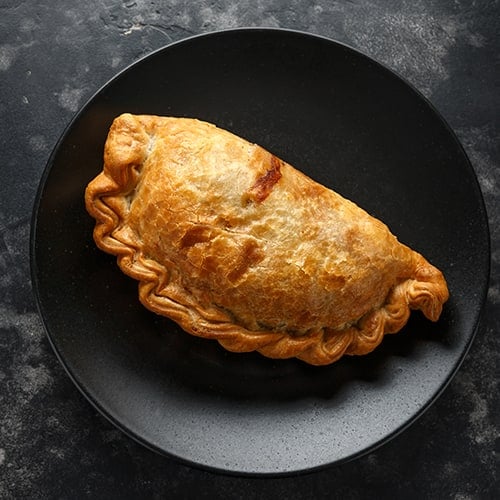
7. Cornish Pasties
A pasty (pronounced past-ee) is a hand pie made of shortcrust pastry and sweet or savory fillings. The dough is shaped into a semi-circle, crimped on the side, and baked. Unlike other pastries that require a delicate, flaky shortcrust, the pasty needs a sturdy crust that will hold its shape. Kneading the shortcrust ensures it will be strong enough to support the heavy filling inside.
The traditional Cornish pasty filling is made of beef, potatoes, onion, and rutabaga. To be considered a Cornish pasty, the handpie must contain these exact ingredients in the correct ratio. The strict guidelines for making this authentic hand pie are due to its protected designation of origin. If the recipe isn’t followed exactly, it cannot be labeled as a Cornish pasty.
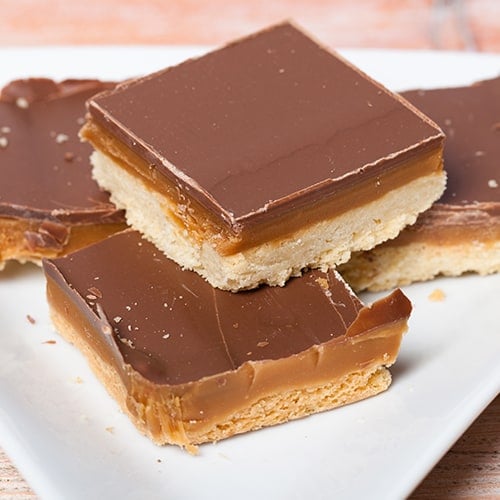
8. Millionaires Shortbread
Millionaires shortbread is made with a shortbread base, followed by a layer of caramel filling, and a thick topping of chocolate ganache. When all the layers have set, the dessert is cut into squares or bars.
This layered dessert actually comes from Australia, where it’s known as caramel shortbread or caramel slice. The nickname “millionaires shortbread” was adopted in Scotland, presumably because the dessert is so rich.
Glossary of British Baking Terminology
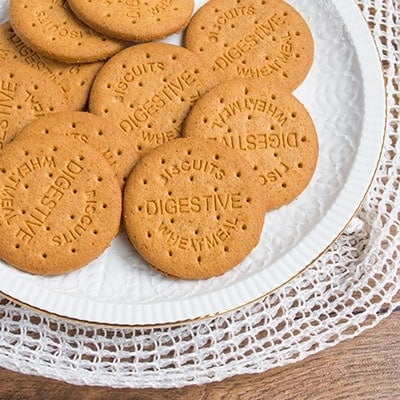
These are words that you may have read in a British recipe or heard on The Great British Baking Show. Before you get started with baking your first Victoria Sponge or Swiss Roll, familiarize yourself with these terms so you can follow the recipe successfully.
- Bicarbonate of Soda - Bicarbonate of soda, or bicarb soda, is the same thing as baking soda. It’s a leavening agent used to make your baked goods rise.
- Biscuit - British biscuits are what Americans refer to as cookies or crackers. They are small, firm baked goods that can be sweet or savory. Digestive biscuits are similar to a graham cracker and are served with tea.
- Caster Sugar - Caster sugar has a finer consistency than granulated sugar but it’s not as powdery as confectioner’s sugar. It’s a common ingredient in the UK but not widely available in the US.
- Creme Pat - The full name for this classic vanilla-flavored custard is creme patissiere. It’s commonly used as a filling for pastries, cakes, or tarts.
- Choux Pastry - Choux pastry, pronounced shoe pastry, is a light dough that relies on steam to rise. The high moisture content of the dough evaporates as it bakes, creating air pockets that can be piped with fillings.
- Icing Sugar - Icing sugar is finely ground sugar with a powdery consistency. In the US, we call it confectioner’s sugar or powdered sugar.
- Prove - To prove your dough is to let it rise. Proving or proofing is the period when the dough becomes aerated by the activated yeast, causing it to grow in size.
- Pudding - In America the word pudding refers to custard, but the British meaning is not so clearly defined. Most commonly when the word pudding is used by itself, it’s a generic term for dessert. It’s also used to denote a sweet or savory dish that has been steamed or boiled, like Christmas pudding.
- Self-Raising Flour - Self-raising flour is the same thing as self-rising flour. It contains baking powder and salt so it provides a good rise to baked goods.
- Sponge - The word sponge is sometimes used interchangeably with cake, but specifically refers to a cake made with butter, sugar, eggs, flour, and a rising agent to make the texture light and airy.
- Strong Flour - Strong flour is the same thing as bread flour or hard flour. It has a high gluten content and requires strong kneading. Different types of flour yield different results and strong flour is the best choice for crusty, chewy breads.
- Suet - Suet is animal fat that comes from around the kidneys of a cow or sheep. It’s prized because of its high smoke point, which makes it suited to baking pastry and puddings.
- Sultanas - Sultanas are made from dried seedless white grapes and look like small, golden raisins. They are more plump and sweet than raisins.
- Treacle - Treacle is the equivalent of molasses, a byproduct of sugar refining. There are two types of treacle used in British baking, light treacle and black treacle. The light form is gold in color and can replace maple syrup or honey. Black treacle is thick, dark, and richly flavored.
British Weight Conversions
While following a British recipe, you’ll notice that ingredients are measured by weight and not volume. In the US, we use measuring cups and measuring spoons, but the rest of the world relies on a kitchen scale to make sure they have the exact amounts needed. Baking requires a high level of accuracy and using a kitchen scale is the best way to ensure that you get consistent results every time. Weighing your ingredients is highly recommended, but here’s a cheat sheet to get you started.
| Ingredient | 1 Cup | 3/4 Cup | 2/3 Cup | 1/2 Cup | 1/3 Cup | 1/4 Cup |
| Flour (unsifted) | 120 grams | 90 grams | 80 grams | 60 grams | 40 grams | 30 grams |
| Flour (sifted) | 110 grams | 80 grams | 70 grams | 55 grams | 35 grams | 27 grams |
| Granulated Sugar | 200 grams | 150 grams | 130 grams | 100 grams | 65 grams | 50 grams |
| Icing Sugar | 100 grams | 75 grams | 70 grams | 50 grams | 35 grams | 25 grams |
| Brown Sugar | 180 grams | 135 grams | 120 grams | 90 grams | 60 grams | 45 grams |
| Butter | 240 grams | 180 grams | 160 grams | 120 grams | 80 grams | 60 grams |
| Sultanas | 175 grams | 150 grams | 130 grams | 100 grams | 65 grams | 50 grams |
Now that you’ve brushed up on the basics, you’re ready to tackle some British recipes! Impress your customers with a bakery case filled with beautiful cakes and desserts they’ve only seen on TV.
Related Resources

Guide to Global Cuisine
While landscapes, art, history, language, and traditions are important threads in a region's cultural fabric, food weaves all these things together and tells the story of a geographic area. Career culinarians working to master their craft must have a thorough understanding of the various global cuisines. By immersing themselves in the diverse flavors and cooking techniques of different regions, chefs can expand their culinary repertoire and create innovative dishes that will excite and inspire a diverse clientele. Click below to skip to a specific type of cuisine: French Cuisine Thai Cuisine Indian Cuisine Mexican Cuisine Japanese Cuisine Italian Cuisine Chinese Cuisine Vietnamese Cuisine Korean Cuisine Greek Cuisine British Cuisine Middle Eastern Cuisine Brazilian Cuisine Spanish Cuisine African Cuisine What Is Cuisine? Cuisine is a fundamental aspect of culture that encompasses the foods and methods of preparation traditional to a specific region or population. Factors such as climate, economic conditions, and cultural practices influence the development of unique cuisines. Climate determines the raw materials available for ingredients and the fuel supply for food preparation. For example, regions bordering an ocean may have a cuisine that heavily features seafood, while areas with fertile land may have a cuisine rich in vegetables and grains. Economic conditions also play a significant role in shaping cuisine by regulating trade and influencing the availability of certain ingredients. Wealthier regions may have access to a wider variety of global spices, resulting in more diverse and complex dishes. In contrast, regions with limited resources may rely on simple, staple foods for sustenance. Religious or sumptuary laws can impact the ingredients and cooking methods used in a cuisine. For example, some religions prohibit the consumption of certain foods, such as pork or alcohol, leading to alternative dishes and preparation methods that adhere to religious dietary restrictions. An amalgamation of socio-economic influences, cuisine helps tell a story of a region's footprint, both past and present. Types of Cuisine Understanding major global cuisines allows chefs to stay relevant in today's dynamic culinary scene. With the world becoming increasingly interconnected, diners are more adventurous and interested in trying new and niche flavors. Chefs well-versed in global cuisines can tap into this growing foodservice trend and attract a wider customer base by offering authentic and fusion dishes that showcase a blend of different culinary traditions. 1. French Cuisine Renowned for its sophistication and rich culinary tradition, French cuisine is considered one of the cornerstones of global gastronomy. Its influence stretches far beyond the borders of France, and culinary students are taught to use French mother sauces as the basis for their unique sauce creations. French cuisine emphasizes high-quality ingredients, meticulous preparation techniques, and a deep respect for culinary traditions. French chefs also take great care in the presentation of their dishes, often focusing on aesthetics and intricate plating presentations. Even their quick bites and breakfast staples like quiches, crepes, and baguettes offer elegance. The flavor profile of French cuisine is often described as complex and well-balanced. Key ingredients in French cooking include butter, cream, herbs, and wine, creating rich and flavorful dishes. In Southern France, you'll find the bold flavors of dishes like cassoulet (haricot beans, sausage, pork, mutton, and preserved goose stew) and duck confit (cured duck legs slow-cooked in their own fat), while the East boasts Alsatian specialties like choucroute carnie (sauerkraut with sausages and charcuterie meats). From the hearty stews of the North, such as coq au vin and beef bourguignon, to the seafood dishes of the coastal regions like Bouillabaisse, to vegetable dishes like ratatouille from Provence, each region of France offers a unique culinary experience. While their savory dishes delight, we must not forget their patisserie. French pastries like macaroons, croissants, and eclairs are mimicked in bakeries worldwide. Regional French Cuisines: Normandy cuisine, Brittany cuisine, Alsace cuisine, Lorraine cuisine, Burgundy cuisine, Auvergne Provence cuisine, Marseille cuisine, Basque Country cuisine Popular French Flavors: Butter, cream, herbs, wine Popular French Dishes: Coq au vin, beef bourguignon, quiche, crepes, salade nicoise, bouillabaisse, ratatouille, creme brulee, macaroons, croissants, baguettes Signature French Cooking Methods: Sauteing, poaching, braising, and flambeing 2. Thai Cuisine Thai cuisine is renowned for its balance of sweet, sour, salty, and spicy flavors, creating dishes that are both complex and harmonious. Key ingredients in Thai cuisine include lemongrass, galangal, kaffir lime leaves, Thai basil, fish sauce, and coconut milk. These ingredients contribute to the distinct and aromatic flavors that are characteristic of Thai dishes. The use of chili peppers, garlic, and shallots adds a spicy kick, while the addition of coconut milk provides a rich and creamy texture. Thai cooking techniques often involve stir-frying, grilling, and steaming, which help preserve freshness and flavor while creating dishes that are both visually appealing and delicious. The use of a mortar and pestle to pound fresh herbs and spices is also a common practice in Thai cooking. Central Thailand boasts two world-famous dishes: pad thai, a stir-fried noodle dish in a tamarind-based sauce, and tom yum goong, a spicy and sour soup made with shrimp, lemongrass, and chili peppers. However, many regional Thai cuisines showcase the country's culinary heritage. In Northern Thailand, dishes feature mild herbaceous and sometimes bitter flavors, often accompanied by sticky rice. The Northeastern (Isan) is known for som tum, a green papaya salad made with chilies, tomatoes, peanuts, and often pla ra (a Thai fermented fish product). We can't forget Thai tea; black tea spiced with star anise, cardamom, and vanilla beans that is sweetened with condensed milk and topped with evaporated milk. It has fused with Taiwanese cuisine and become a beloved boba tea flavor. Regional Thai Cuisines: Central Thai cuisine, Northern Thai cuisine, Isan (Northeastern) Thai cuisine, Southern Thai cuisine Popular Thai Flavors: Lemongrass, galangal, kaffir lime leaves, Thai basil, fish sauce, coconut milk, chili peppers, garlic Popular Thai Dishes: Pad thai, tom yum goong, green curry, som tam, massaman curry, mango sticky rice Signature Thai Cooking Methods: Stir-frying, grilling, and steaming 3. Indian Cuisine Known for its bold flavors, Indian cuisine utilizes rich spices like cumin, coriander, turmeric, and garam masala, and pairs them with aromatic herbs. These spices not only add depth and complexity to dishes but also offer a unique sensory experience. Cooking methods in Indian cuisine vary across regions but commonly include techniques such as sauteing, frying, roasting, and braising. The use of a tandoor oven, a traditional clay oven, is prevalent in Indian cooking, particularly for preparing dishes like tandoori chicken and naan bread. Additionally, the art of tempering spices in hot oil, known as tadka, is a fundamental technique that enhances the flavors of many Indian dishes. Regional cuisines within India offer a diverse range of culinary traditions, each with its own distinct flavors and cooking styles. From the vegetarian delights of Gujarati cuisine in the West to fiery dishes of Andhra Pradesh to the creamy curries of Punjab, the regional diversity of Indian cuisine reflects the country's rich cultural heritage and culinary history. Indian cuisine is also known for its vibrant street food culture, offering a plethora of savory snacks and sweet treats, such as chaat, samosas, and jalebi. Indian cuisine has had a significant influence on culinary practices beyond its borders, with the use of spices like curry powder and turmeric becoming commonplace in many international kitchens. Regional Indian Cuisines: Gujarati cuisine, Andhra Pradesh cuisine, Punjab cuisine Foundational Indian Ingredients/Flavors: Cumin, coriander, turmeric, and garam masala, cilantro, and mint Popular Indian Dishes: Butter chicken, biryani, naan bread, palak paneer, rogan josh, masala dosa, tiki masala, tandoori chicken, samosas Signature Indian Cooking Methods: Sauteing, frying, roasting, braising, baking in a tandoor oven 4. Mexican Cuisine Mexican cuisine uses fresh, flavorful ingredients such as corn, beans, tomatoes, avocados, chilies, herbs, and spices. Corn plays a central role in Mexican cuisine; it’s used to make staples like tortillas, tamales, and pozole. Huitlacoche, a type of fungus that develops on organic corn kernels before they reach full maturity, is highly regarded as a delicacy and used as a topping or incorporated as an ingredient to enhance flavors and add a touch of sophistication. Other common ingredients include cilantro, cumin, garlic, and onions, which add depth and complexity to Mexican dishes. Grilling, frying, steaming, and braising are commonly used techniques that help enhance the natural flavors of the ingredients. Traditional Mexican cooking also involves the use of comals (flat griddles) for making tortillas and salsas, as well as molcajetes (stone mortars) for grinding spices and herbs. Mexican cuisine is famous for its iconic dishes such as tacos, enchiladas, tamales, and guacamole. Chips and flights of different types of salsa are a beloved appetizer. Tacos have become an international staple due to their versatility; they can be filled with a variety of ingredients such as meats, fish, or vegetables. Mexico is a diverse country with a wide range of regional cuisines. Some of the most well-known include Oaxacan cuisine, known for its complex moles and use of indigenous ingredients, and El Norte for its Birria (goat or beef slow cooked in consomme), Yucatecan cuisine, which features dishes like cochinita pibil (pulled pork shoulder marinated and braised in achiote paste, orange juice, and lime) and panuchos (fried tortillas filled with refried black beans and topped with shredded meat, lettuce, avocado, pickled onions, and salsa). Regional Mexican Cuisines: Oaxacan cuisine, Yucatecan cuisine, El Norte cuisine, Bajio cuisine, South Pacific cuisine, Veracruz cuisine Foundational Mexican Flavors/Ingredients: Corn, chilies, beans, tomatoes, avocados, tomatillos, meats, cotija cheese, and queso Popular Mexican Dishes: Tacos, enchiladas, salsas, moles, birria, tortillas, pozoles, cochinita pibil, carne asada Signature Mexican Cooking Methods: Grilling, frying, steaming, and braising 5. Japanese Cuisine Japanese cuisine, known for its delicate flavors, seasonal ingredients, and beautiful presentations, has gained popularity worldwide. Regional cuisines in Japan offer a diverse range of flavors and cooking styles. For example, Kaiseki cuisine from Kyoto focuses on seasonal ingredients and intricate presentation, while Okinawan cuisine incorporates influences from Southeast Asia. Japanese cooking methods emphasize precision and respect for ingredients. Techniques like sushi-making, tempura frying, and noodle-making require skill and attention to detail. Traditional Japanese cooking also includes methods like grilling, steaming, and simmering, which enhance the natural flavors of the ingredients. Omakase is a highly esteemed dining tradition originating from Japan, renowned for its personalized and exquisite culinary experience. During an omakase meal, patrons place their trust in the skilled chef to curate and present a delectable feast, typically consisting of multiple courses crafted with the finest, seasonal ingredients. Rice, fish, soy sauce, and seaweed are staple ingredients in Japanese cuisine, as are tofu, noodles, and vegetables like daikon radish and bamboo shoots. Sushi dishes, comprised of vinegared rice topped with seafood or vegetables, have become a global favorite. Sashimi, thinly sliced raw fish served with soy sauce and wasabi, showcases the freshness of the ingredients. Japanese tempura features lightly battered and fried seafood and vegetables, while ramen varieties are comforting noodle soups with various toppings. Not just seafood and delicate flavors, Japan produces some of the most expensive and prized beef in the world: Wagyu and Kobe beef. Born in Uji, matcha, a finely ground powder made from specially grown and processed green tea leaves, is a popular ingredient in Japanese cuisine for traditional tea ceremonies, desserts, and savory dishes. Regional Japanese Cuisines: Hokkaido cuisine, Kansai cuisine, Tohoku cuisine, Kanto cuisine, Chubu cuisine, Chugoku cuisine, Shikoku cuisine, Kyushu cuisine Foundational Japanese Flavors/Ingredients: Rice, fish, soy sauce, miso, seaweed, wasabi, premium beef, matcha, noodles Popular Japanese Dishes: Sushi, sashimi, tempura, donburi, ramen, udon, soba, yakitori, katsu curry, miso soup Signature Japanese Cooking Methods: Sushi rolling, sashimi slicing, grilling, steaming, frying, and simmering 6. Italian Cuisine Italian restaurants can be found in almost every corner of the globe, showcasing the popularity and versatility of Italian dishes. Italian cooking methods often emphasize simplicity and quality ingredients. Pasta is typically cooked al dente, meaning it is firm to the bite, while pasta sauces are made from scratch, often using fresh ingredients like tomatoes, herbs, and olive oil. These ingredients form the foundation of many classic Italian dishes and are essential for creating authentic flavors. Grilling, roasting, and braising are common cooking techniques used to create flavorful dishes that highlight the natural tastes of the ingredients. Global chefs pay a premium for DOP ingredients like prosciutto di Parma, Parmigiano Reggiano, San Marzano tomatoes, and buffalo mozzarella. Some notable regional Italian cuisines include the seafood-focused dishes of Sicily, like pasta con le sarde (savory sauce made with sardines, wild fennel, raisins, pine nuts, and saffron mixed with bucatini pasta and garnished with toasted breadcrumbs), and Tuscany's grilled meats and hearty stews like bistecca alla Fiorentina (tender loin steak from a young steer or heifer grilled on the bone until it reaches a rare level of doneness). Lombardy offers rich and creamy risotto, a rice dish cooked with broth and flavored with ingredients like mushrooms or saffron. In Rome, simple pasta dishes like cacio e pepe and carbonara are popular. Globally recognized Italian dishes include pastas such as spaghetti carbonara, lasagna, and fettuccine alfredo. Pizza, originating from Naples, has also become a globally recognized Italian dish, mimicked and reimaged into various pizza styles that cater to different tastes around the world. Regional Italian Cuisines: Sicilian cuisine, Tuscan cuisine, Roman cuisine, Lombardy cuisine, Lazio cuisine, Campania cuisine Foundational Italian Flavors/Ingredients: Basil, oregano, tomatoes, mozzarella, pasta, olive oil Popular Italian Dishes: Pizza, pasta dishes, cured meats, DOP cheeses Signature Italian Cooking Methods: Grilling, roasting, braising, baking in a wood-fired pizza oven 7. Chinese Cuisine With a history spanning thousands of years, Chinese cuisine is characterized by dishes that balance sweet, sour, salty, pungent, and bitter flavors. Chinese 5 spice, comprised of star anise, cloves, Chinese cinnamon (cassia), Sichuan peppercorns, and fennel seeds, exemplifies this harmonious blend of sweet, savory, and spicy notes emblematic of Chinese cooking. China is a vast country with diverse regional cuisines that vary in flavors, ingredients, and preparation methods. Some of the most well-known regional cuisines include Sichuan cuisine, renowned for its bold and spicy flavors; Cantonese cuisine, which emphasizes fresh ingredients and delicate flavors; and Shanghainese cuisine, characterized by sweet and savory dishes. Stir-frying is a popular cooking method that involves quickly cooking ingredients in a wok pan over high heat to preserve their texture and flavor. Other common cooking techniques include steaming, braising, deep-frying, and roasting. Chinese cuisine relies heavily on fresh ingredients such as vegetables, meats, seafood, and grains. Common ingredients include soy sauce, ginger, garlic, scallions, and various spices such as star anise, Sichuan peppercorns, and ginger. Asian noodles, rice, and tofu are staple ingredients. Some popular Chinese dishes include Peking duck, a duck dish with crispy skin; Kung Pao chicken, a spicy stir-fry dish with peanuts and vegetables; and Dim Sum, a selection of small savory and sweet dishes served in steamers, typically for breakfast. China also has a rich tea culture steeped in ceremony. Their Dragon Well, Tie Guan Yin, Da Hong Pao, and Pu-erh teas are considered some of the finest in the world. Regional Chinese Cuisines: Sichuan cuisine, Cantonese cuisine, Shanghainese cuisine Foundational Chinese Flavors/Ingredients: Soy sauce, plum sauce, star anise, Sichuan peppercorns, five-spice powder, rice, noodles, tofu Popular Chinese Dishes: Peking duck, dim sum, moo shu pork, kung pao chicken, wonton noodle soup, and scallion pancakes Signature Chinese Cooking Methods: Stir-frying, steaming, braising, deep-frying, and roasting 8. Vietnamese Cuisine Vietnamese cuisine is renowned for its fresh flavors, vibrant colors, and diverse ingredients that create a harmonious balance of sweet, savory, sour, and spicy tastes. Regional cuisines within Vietnam offer unique specialties that reflect the local climate and available ingredients. Northern Vietnamese cuisine is influenced by Chinese flavors and tends to be milder, featuring dishes like pho (broth, herb, meat, and rice noodle soup) and cha lua (porked sausage steamed in banana leaf). Central Vietnamese cuisine is known for its spicier dishes like bun bo hue (spicy beef noodle soup) and banh xeo (crispy, savory pancakes). Southern Vietnamese cuisine is characterized by its use of coconut milk, tropical fruits, and bold flavors in dishes like com tam (broken rice with grilled pork). Common ingredients in Vietnamese cuisine include fresh herbs like mint, cilantro, and Thai basil, as well as lemongrass, fish sauce, rice noodles, and a variety of fresh vegetables such as bean sprouts, cucumbers, and lettuce. The period of French colonial rule, which lasted from the mid-19th century to the mid-20th century, influenced Vietnamese cuisine by introducing ingredients such as baguettes, pate, and coffee, which have become integral parts of the food culture. The fusion of French and Vietnamese culinary elements is evident in dishes like Banh Mi, a Vietnamese sandwich that features a French baguette filled with a variety of meats, pickled vegetables, and herbs. Another popular dish that showcases this fusion is Bo Kho, a hearty beef stew that incorporates French-style braising techniques with Vietnamese spices and flavors. Regional Vietnamese Cuisines: Northern Vietnamese cuisine, Central Vietnamese cuisine, Southern Vietnamese cuisine Foundational Vietnamese Flavors/Ingredients: Mint, cilantro, Thai basil, lemongrass, fish sauce, rice noodles, bean sprouts, cucumbers, and baguettes Popular Vietnamese Dishes: Pho, banh xeo, bun cha, cao lau, banh mi, banh xeo, cha cha Signature Vietnamese Cooking Methods: Stir-frying, steaming, grilling, braising, simmering 9. Korean Cuisine Korean cuisine is known for its bold flavors, vibrant colors, and use of fermentation to add tang. Fermented foods like kimchi, soybean paste, and doenjang are staples. Gochujang, a spicy and savory red chili paste, is another essential ingredient in Korean cooking. Common elements in Korean dishes include rice, vegetables such as cabbage, radish, and mushrooms, meats like beef, pork, and chicken, seafood, and seasonings such as garlic, ginger, sesame oil, soy sauce, and red pepper flakes. Some popular Korean dishes include bibimbap (mixed rice with vegetables and meat) from the Jeolla Province, bulgogi (marinated grilled beef) from the Seoul and Gyeonggi provinces, dakgalbi (spicy stir-fried chicken with rice cakes and vegetables) from the Gangwon Province, and mandu (various dumplings) from the Pyongyang region. Korean cuisine utilizes grilling, stir-frying, boiling, and steaming. Grilling is particularly popular, and Korean BBQ restaurants are becoming a sought-after dining experience worldwide as diners appreciate the novelty of grilling their own meat at the table. Banchan, small side dishes served alongside the main meal, are essential parts of Korean dining culture, offering a variety of flavors and textures that complement the main dishes. Korean royal court cuisine, the culinary tradition of the Joseon Dynasty, uses refined flavors and elaborate presentation. In the 21st century, a resurgence of this esteemed cookery style has captivated modern palates. Notable dishes such as gujeolpan, a nine-sectioned plate featuring a medley of meats, vegetables, and pancakes, sinseollo, a flavorful hot pot cooked in a grand silver vessel, pyeonyuk, thinly sliced and seasoned meat, as well as an array of namul and kimchi, continue to honor the legacy of Korean royal dining. Regional Korean Cuisines: Jeolla Province cuisine, Gangwon Province cuisine, Pyongyang region cuisine, and Korean royal court cuisine Foundational Korean Flavors/Ingredients: Kimchi, soybean paste, gochujang, radish, mushrooms, meats, garlic, ginger, sesame oil, soy sauce, and red pepper flakes Popular Korean Dishes: Bibimbap, bulgogi, dakgalbi, mandu, banchan Signature Korean Cooking Methods: Grilling, stir-frying, boiling, and steaming 10. Greek Cuisine Greek cuisine is known for its fresh, localized ingredients and rich culinary traditions. Key elements in Greek cooking include EVOO (extra virgin olive oil), garlic, oregano, lemon, and feta cheese. These ingredients are often used to create dishes that are both hearty and healthy. In fact, the Mediterranean diet, of which Greek cuisine is a key component, is known for its health benefits and emphasis on fresh fruits, vegetables, whole grains, and olive oil. Regional variations in Greek cuisine reflect the diverse landscapes and culinary influences across the country. For instance, on the island of Crete, dishes are often prepared with olive oil, wild greens, and aromatic herbs. In northern Greece, Turkish and Balkan influences can be seen in meat-based dishes. Greek cooking methods often involve grilling, roasting, and stewing. Some of the most iconic dishes in Greek cooking include moussaka, a layered casserole featuring eggplant, minced meat, and creamy bechamel sauce; spanakopita, a savory pastry filled with spinach and feta cheese; and souvlaki, grilled meat skewers served with pita bread and tzatziki sauce. Meze, small plates of appetizers or snacks, plays an important role in Greek dining culture. Meze dishes can range from various olives and cheeses to dips like tzatziki and hummus, along with grilled vegetables. Ouzo, a traditional Greek alcoholic beverage with an anise flavor, is often enjoyed alongside meze dishes to enhance the dining experience. Regional Greek Cuisines: Peloponnese cuisine, Roumeli cuisine, Macedonian cuisine, Ionian cuisine, Dodecanese cuisine, North Aegean cuisine Popular Greek Flavors: Olive oil, garlic, oregano, lemon, fresh vegetables, fresh fruits, and feta cheese Popular Greek Dishes: Moussaka, spanakopita, souvlaki, meze, pita bread, hummus, tzatziki, horiatiki salad Signature Greek Cooking Methods: Grilling, roasting, and stewing 11. British Cuisine British cuisine reflects the rich history and diverse influences that have shaped it over the centuries. Key ingredients in British cooking include meats such as beef, lamb, and pork, as well as seafood like fish and shellfish. Potatoes, carrots, and cabbage, savory herbs like thyme, rosemary, and parsley, and flavorings like vinegar, mustard, and malt are also staples in British dishes. Cooking methods often involve roasting, stewing, and baking. Roast beef and Yorkshire pudding are iconic examples of traditional British roasts, while fish and chips, a dish of battered and fried fish served with thick-cut fries, is a beloved staple across the country. Start your day in the British Isles with a full English breakfast, and you’ll be full until teatime; this hearty meal consists of eggs, bacon, sausage, black pudding, baked beans, mushrooms, tomatoes, and toast. A quintessentially British tradition, afternoon tea is typically served between 3 p.m. and 5 p.m., and offers a selection of finger sandwiches, scones with clotted cream and jam, British baked goods, and, of course, a pot of hot tea. Another classic British comfort food is Shepherd's pie, a savory dish made with minced meat and topped with mashed potatoes. Regional variations in British cuisine are pronounced, with each region boasting its own specialties. For example, Scotland is known for its haggis, a dish made from sheep's heart, liver, and lungs, and renowned for its premium Scotch whiskey, while Wales is famous for its traditional Welsh cakes and leek soup. Regional British Cuisines: English cuisine, Scottish cuisine, Welsh cuisine, Northern Irish cuisine Popular British Flavors/Ingredients: Vinegar, malt, mustard, beef, lamb, potatoes, carrots, cabbage, thyme, rosemary, and parsley Popular British Dishes: Yorkshire pudding, Cornish pasty, haggis, cranachan, Welsh cakes, boxty, soda bread, Scotch whiskey, mead Signature British Cooking Methods: Roasting, stewing, frying, and baking 12. Middle Eastern Cuisine Hospitality is a central aspect of Middle Eastern culture, and large, communal meals are used to bring people together and showcase the best of their culinary traditions. Common ingredients in Middle Eastern cooking include olive oil, garlic, chickpeas, lamb cuts, and a variety of fresh herbs and spices such as cumin, coriander, and sumac. Cooking methods in Middle Eastern cuisine often involve grilling, roasting, and braising. Meats are frequently marinated in flavorful spice blends before being cooked over an open flame or in a clay oven. Vegetables are often roasted or stewed to create rich, savory dishes. Lamb and rice dishes like biryani, kibbeh, and mansaf are staples of regional Middle Eastern cuisines. Other famous dishes include falafel, hummus, and kebabs. Mezze platters are a popular way to enjoy a variety of small dishes, and typically include a selection of olives, cheeses, dips, and grilled vegetables. Middle Eastern cuisine offers delectable desserts, such as baklava, Turkish delight, and halva. Baklava is a sweet pastry made of layers of filo dough, nuts, and honey. Turkish delight, also known as lokum, is a chewy confection made of starch and sugar, often flavored with rosewater or citrus. Halva is a dense, sweet confection made from sesame paste or tahini, often mixed with nuts or dried fruits for added texture and flavor. A modern riff off classic Middle Eastern sweets is Dubai chocolate, a pistachio butter and kataifi-filled chocolate candy bar that has captivated the taste buds of those around the globe. Regional Middle Eastern Cuisines: Arab cuisine, Assyrian cuisine, Bahraini cuisine, Balochi cuisine, Cypriot cuisine, Eastern Arabian cuisine, Egyptian cuisine, Emirati cuisine Popular Middle Eastern Flavors: Olive oil, garlic, chickpeas, lamb cuts, cumin, coriander, and sumac Popular Middle Eastern Dishes: Tabouli salad, biryani, kibbeh, mansaf, mezze platters, falafel, hummus, kebabs, baklava, Turkish delight, and halva Signature Middle Eastern Cooking Methods: Grilling, roasting, braising, and baking in a clay oven 13. Brazilian Cuisine Known for its bold and vibrant flavors, Brazilian cuisine incorporates a mix of fresh herbs, spices, juicy fruits, and a variety of meats. Common ingredients include cassava, black beans, rice, coconut, palm oil, and a wide array of tropical fruits such as mango, passion fruit, and guava. Brazilian dishes are often seasoned with ingredients like garlic, onions, cilantro, and cumin, adding depth and complexity. Feijoada is perhaps the most iconic Brazilian dish, a hearty stew made with black beans, pork, and beef. This dish is often served with rice, collard greens, and farofa (toasted cassava flour). Churrasco, a style of barbecue, is also widely popular, featuring grilled meats served with chimichurri sauce. Another famous dish is acai, a superfood berry native to the Amazon region, often served as a refreshing and nutritious smoothie bowl. Acai smoothie bowl businesses are popular amongst health-conscious consumers and those with a sweet tooth alike. From the Amazon rainforest to the coastal regions, Brazilian cuisine encompasses a wide range of flavors, ingredients, and cooking techniques. For example, the northeastern region is known for its seafood dishes and flavorful stews, while the south is famous for its barbecue culture. The Amazon region offers a wide variety of exotic ingredients and dishes influenced by indigenous traditions. Brazil has a thriving street food culture, with vendors selling a variety of snacks and quick meals on the streets. Coxinha (deep-fried chicken croquettes), pastel (fried pastries filled with savory fillings), and pao de queijo (cheese bread) are just a few examples of popular street foods enjoyed by both locals and visitors. Caipirinha, a cocktail made with cachaca (sugarcane spirit), lime, sugar, and ice, is a refreshing drink often enjoyed alongside street food. Regional Brazilian Cuisines: Minas Gerais cuisine, Bahian cuisine, Southern Brazilian cuisine, Northern Brazilian cuisine Popular Brazilian Flavors/Ingredients: Tropical fruits, grilled meats, cassava, black beans, rice, coconut, palm oil, garlic, onions, cilantro, and cumin Popular Brazilian Dishes: Acai bowls, churrasco, feijoada, coxinha, pastel, pao de queijo, chimichurri sauce, and caipirinha Signature Brazilian Cooking Methods: Grilling, stewing, simmering, deep-frying 14. Spanish Cuisine Spain's diverse geography and rich culinary traditions have given rise to a wide range of regional specialties. From the hearty stews of the Basque Country to the fresh seafood of Galicia, each region offers its own unique culinary delights. The influence of Moorish, Jewish, and Roman cultures is seen in the diverse flavors and ingredients used in Spanish cuisine. It’s known for its use of simple cooking techniques that allow the flavors of the ingredients to shine. Grilling, frying, and stewing are popular methods of preparation, with an emphasis on slow cooking to develop rich, complex flavors. Many dishes are seasoned with a combination of paprika, saffron, and other aromatic spices to create a distinctive taste profile. Olive oil, garlic, tomatoes, and fresh herbs and spices are staples in Spanish cooking. Seafood, particularly in coastal regions, plays a prominent role in many dishes, while pork, lamb, and poultry are also common. Spanish cuisine is home to iconic dishes that have gained international acclaim. Paella, a flavorful rice dish cooked with saffron, seafood, and meats, is a staple. Gazpacho, a chilled tomato soup, is a refreshing summer favorite, while churros, fried dough pastries served with chocolate sauce, are a popular dessert. Spanish tapas are a quintessential part of the culinary culture, offering a social dining experience that encourages sharing and sampling a variety of flavors. These small plates can include a wide range of dishes, from cured meats like jamon Iberico to cheeses like Manchego to croquettes and patatas bravas. Tapas are often enjoyed with a glass of wine or sherry, making them a perfect accompaniment to a leisurely evening with friends. Regional Spanish Cuisines: Basque cuisine, Galician cuisine, Pyrenees cuisine, Valencian cuisine, Andalucian cuisine, Catalonian cuisine, Castilla-Leon cuisine Popular Spanish Flavors/Ingredients: Cured meats, saffron, olive oil, garlic, tomatoes, seafood, meats, sherry wine Popular Spanish Dishes: Tapas, paella, gazpacho, churros, tortilla de patatas, cocido madrileno, croquetas, chorizo, fabada Signature Spanish Cooking Methods: Grilling, frying, and stewing 15. African Cuisine African cuisine offers a diverse and vibrant culinary experience that reflects the continent's rich cultural heritage and unique flavors. It uses bold spices, aromatic herbs, and fresh, locally sourced ingredients that showcase the region's agricultural abundance. Prevalent in African cuisine are maize, sorghum, millet, and rice, as are meats such as beef, chicken, lamb, and goat. African cuisine incorporates a range of cooking methods, including grilling, roasting, stewing, and frying. Many dishes are prepared using traditional cooking techniques such as simmering in a flavorful broth or marinating meats in aromatic spices before cooking. Africa's vast size and diverse landscapes contribute to the wide range of culinary traditions found across the continent. Staples like cassava and plantains are widely used in West African cuisine, while North African dishes are known for their use of couscous and aromatic spices. South Africa is known for its rooibos tea, a caffeine-free herbal tea that is enjoyed both hot and cold. From the fragrant Moroccan tagines, slow-cooked stews made with meat, vegetables, and aromatic spices, to the spicy Ethiopian doro wot, a flavorful chicken stew served with injera, a spongy flatbread made from teff flour, African cuisine is home to a plethora of iconic dishes that have gained international acclaim. Regional African Cuisines: West African cuisine, Ethiopian cuisine, Central African cuisine, East African cuisine, North African cuisine, South African cuisine Popular African Flavors/Ingredients: Meats like beef, chicken, and goat, maize, sorghum, millet, rice, cassava, plantains, berbere, rich spices, and local herbs Popular African Dishes: Doro wot and injera, tagines, cous cous, jollof rice, fufu, ugali, bunny chow, suya, bobotie moin moin, chakalaka Signature African Cooking Methods: Grilling, roasting, stewing, and frying Global cuisines have a profound impact on America's culinary landscape, shaping the way our globalized society eats and experiences food. Chefs who are knowledgeable about major global cuisines can successfully experiment with fusion cooking, pushing the boundaries of traditional culinary norms and delighting diners with exciting and unexpected flavor combinations. By embracing and appreciating the unique characteristics of different global cuisines, chefs can share the richness and diversity of the world's culinary heritage.
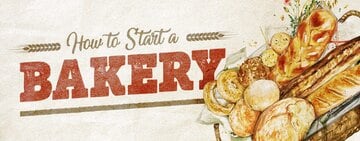
How to Start a Bakery
Whether you dream of opening a donut shop or a boulangerie, starting a bakery allows you to serve niche markets and express culinary creativity without taking on the financial burden of opening a restaurant. You can even start your bakery business from home before investing in a commercial space. While bakeries are comparatively accessible foodservice businesses, they present unique challenges. From writing a bakery business plan to getting funding and filing for permits, we walk you through each step of opening a bakery. Shop All Bakery Supplies Jump to a specific step of opening a bakery: Choose Your Bakery Style Write a Bakery Business Plan Get Startup Loans Lease a Bakery Location Bakery Permits and Licenses Order Bakery Equipment Design a Bakery Layout Hire Bakery Staff Advertise Your Bakery Host a Bakery Grand Opening How to Start a Baking Business Whether you're passionate about creating decoratively frosted cakes or artisan sourdough loaves, you must create an action plan for turning your passion for baking into a business. Discover the steps of opening a bakery below. 1. Choose a Bakery Style While there are many bakery business models, they all fall under one of two umbrella categories: retail and wholesale. Retail and wholesale bakeries make similar products, but they have different needs and customer bases. Opening and Operating a Retail Bakery Retail bakeries are the most common type of bakery; they sell baked goods and loaves of bread directly to customers. Retail bakeries come in many different forms, and they often specialize in a particular type of baked good. They require both front- and back-of-house space. Types of Retail Bakeries Discover the most popular retail bakery business models below: Bakery Cafe - This type of bakery is a combination of a bakery and cafe, and they typically sell baked goods like bread, pastries, and cookies. They also pair their baked goods with coffee and tea. Bakery cafes typically have a dining space where customers can sit and eat. Counter Service - While counter service bakeries have a front-of-house, most do not have a dining space. Instead, they have a counter where guests can order freshly baked goods to take home. Bakery Food Trucks - Rather than using a brick-and-mortar store, food truck bakeries sell their products from a mobile truck. Due to the small space, many bakery food trucks do not bake in their truck, instead opting to bake their products ahead of time in a commissary kitchen or home bakery. Specialty Bakeries - A specialty bakery typically focuses on one type of baked good, such as wedding cakes, cupcakes, or gluten-free baked goods. This type of bakery can excel because they offer niche products that customers either cannot find elsewhere or that are better than the products offered at less-specialized bakeries. Home Bakeries - This type of bakery is becoming more common, especially because you don't need a lot of startup capital or culinary experience to open a home bakery. Home bakeries typically market their products online and then ship them to customers. Many home bakeries are also very niche or offer twists on classic baked goods. Opening and Operating a Wholesale Bakery The other main type of bakery is a wholesale bakery. Rather than selling their products directly to customers, wholesale bakeries market their baked goods to businesses like grocery stores, restaurants, delis, and cafes. Because wholesale bakeries have to meet the demands of commercial customers, they are typically larger than retail bakeries. Wholesale bakeries don't need to have a front-of-house or a desirable, high-traffic location. However, wholesale bakeries must produce high volumes of baked goods. This requires a large space and lots of baking equipment, resulting in higher startup costs. Back to Top 2. Write a Bakery Business Plan The first step in opening your new establishment should be to write a bakery business plan. The business plan is an integral part of starting a bakery business because it lays out what type of bakery you want to open, how it's going to be structured, what sort of products you're going to sell, marketing strategies, and financial projections. There are seven main sections to a bakery business plan: Executive Summary Company Overview and Description Market Analysis Business Offerings Management Plan and Ownership Structure Marketing and Advertising Strategy Financial Projections Your business plan serves as the foundation for your business, and a strong plan can help you get funding and make the process of opening a new bakery easy. Back to Top 3. Obtain Loans and Startup Capital When starting a bakery, there are many costs that you'll need to consider, such as leasing a commercial space, getting insurance, outfitting your space with equipment, hiring and training staff, stocking your kitchen, and paying for utilities. As a result, you'll need to have a significant amount of money available to cover these costs. Additionally, it may take a few months after opening for your bakery to become profitable, so you'll need cash on hand to cover costs for several months after opening. If you’re wondering how to open a bakery with no money, you'll need to take out loans. There are three common ways business owners get funding: commercial loans, business lines of credit, and small business loans. Traditional Commercial Loan - You can apply for a traditional commercial loan at any major or local bank. This type of loan has lower interest rates and provides access to large amounts of capital. However, it requires you to have a high credit score. You may have to wait for months to access the money. Business Line of Credit - A line of credit is similar to a credit card. You get approved to use up to a certain amount, but you're only charged for the amount you use. Additionally, as you pay off the balance, you can access more credit. But, a line of credit doesn't allow you to access as much money as other loan types and requires a higher lending standard. Small Business Loan - Created by the Small Business Association, a small business loan is a type of loan that aims to protect small businesses and provide them with startup capital. Small business loans typically have lower interest rates and are available to people with borderline credit. They require collateral and may take longer to be approved than other loan types. Cost to Open a Bakery Bakery startup costs range between $10,000 and $50,000. The vast startup cost price range reflects the diverse array of bakeries. How much money you need to start a bakery depends on its location, equipment, staffing requirements, and menu items. Back to Top 4. Lease a Commercial Bakery Space Once you've secured funding, you can start looking for a commercial space for your bakery. The type of commercial space you need depends on the type of bakery you're opening. For example, if you're opening a food truck bakery, you'll need to purchase the truck and you may want to look into renting space in a commissary kitchen. Retail bakeries will want to look for a space in a central location close to their target demographic that also has a front-of-house area. Because wholesale bakeries sell their products to businesses rather than customers, they can be located farther from the city center or populated areas. Best Place to Open a Bakery The best place to open a bakery is at an accessible location near your suppliers and your target demographic. Regardless of the type of bakery you're opening, there are universal considerations for where you start your bakery business. Consider the following in your bakery location analysis: Demographics Accessibility Proximity to Suppliers Competition Size and Space Requirements Health Regulations and Zoning Safety and Crime Rates Once you've found a suitable location for your business, you can hire a lawyer to draw up and negotiate a lease with the landlord. To protect yourself from any potential issues when negotiating a lease, be sure to specify the length of the lease, any raises in rent that might be included, who will pay for potential renovations, and any utilities that are covered. Back to Top 5. Obtain Bakery Licenses and Permits The foodservice industry is heavily regulated on a federal, state, and local level, and there are some bakery licenses and permits you need to start your baking business. The types of permits you'll need will vary depending on your location, so be sure to check your local laws and regulations to see if there are any specific laws that apply to your new business. Back to Top 6. Order Bakery Equipment The equipment that your bakery will need depends on what type of baked goods you will be preparing. For example, you may need specific pastry supplies to create French pastries. While the specific equipment may change depending on the size and type of your bakery, there are several purposes you need to fill: Dough Preparation - Bread making supplies include equipment like commercial mixers, work tables for kneading, dough dividers, dough sheeters, and dough scales. You may also need holding cabinets, proofing cabinets, retarder/proofer combos, and refrigerators to prepare your dough. Storage - Storage is important for keeping your kitchen organized. Your bakery will require shelving and storage racks. If you're working with bulky bags of flour and sugar, you should invest in trucks, dollies, and carts to move large bags around your kitchen. Baking Equipment - Convection ovens are a great all-purpose piece of bakery equipment because they provide dry heat and bake evenly. If you're preparing a lot of artisan bread, you may want to choose a deck oven to give your products a crispy base. Wholesale bakeries may be looking for high-output ovens, such as roll-in rack ovens or revolving ovens. Display and Sales Equipment - Choosing the right display cases for your baked goods can help boost your sales. You can choose self-service or full-service cases, and there are refrigerated and unrefrigerated options, depending on your needs. In addition to your display cases, be sure to also choose stylish boxes and packaging for your baked goods. Cleaning and Warewashing Supplies - A 3-compartment sink is the centerpiece of any cleaning station. You must also order hand washing stations for your employees, disposable gloves, cleaning chemicals, sponges, scrubbers, and other essential cleaning items. Bakery Smallwares In addition to your large equipment, you must stock your bakery with smallwares, such as mixing bowls, storage boxes, whisks, bread knives, and aprons. We compiled a list of essential bakery equipment to ensure you don't forget anything. You can download the opening a bakery checklist PDF below: Download Baker Smallwares Checklist PDF Back to Top 7. Layout Your Bakery After securing a location and deciding what equipment is needed to start your new bakery, you can plan your bakery kitchen organization. If your bakery has a front-of-house area, you will need to design a floor plan. Learn how to lay out your bakery kitchen and storefront below. Commercial Bakery Kitchen Layout Every bakery kitchen requires four sections: cleaning, storage, food preparation, and meal cooking. Bakery cafes and bakeries with a front-of-house area will also have a service station, where they deliver food to customers. The ideal bakery kitchen layout is determined by the space and the placement of water and gas lines. Organize your bakery kitchen so the four sections flow together and measure your space to make sure you have enough room for your bakery equipment before finalizing your kitchen plan. You will want to lay out your kitchen based on the logical flow of food through the baking process. This starts with the storage area and then goes to the food preparation and meal cooking sections. Once you’ve prepared your baked goods, you can serve them to your customers, package them for display, or ship them to online customers. Finally, your dirty dishes, pots, and pans will end up at the cleaning station. Commercial Bakery Storefront Layout Some bakeries will have a front-of-house area where customers can browse their selection of baked goods. Optimizing your bakery floor plan for ideal product placement and customer comfort prompts purchases. Bakery Layout There are four main bakery layouts, each with its own unique benefits. Straight Bakery Floor Plan - Your bakery display cases are organized in straight lines to make it easy for customers to browse. Angular Bakery Floor Plan - This floor plan uses curved displays to create an upscale presentation. Diagonal Bakery Floor Plan - A diagonal floor plan allows customers to flow through your bakery. Mixed Bakery Floor Plan - Maximize your space by using a combination of all the bakery floor plans. Back to Top 8. Hire and Train Bakery Staff The size of your staff will depend on the scale and style of your bakery. A locally owned and operated bakery with just one location is likely to have a short chain of command. Retail bakeries must hire and train front-of-house staff to take orders and work the cash register. However, most of your bakery staff will work in the back-of-house, preparing your baked goods. Your bakery should have at least one or two employees that have formal training or bakery experience to oversee the actual baking process. You may also want to hire unskilled workers for washing dishes, mixing ingredients, packaging products, and doing other tasks that don't require previous experience or expertise. Some bakeries will also need professional pastry chefs and personnel to complete delicate and specialized tasks. For example, bakeries that bake wedding cakes should look for experienced cake decorators. Bakeries that offer artisan breads should consider hiring someone who specializes in bread baking. Back to Top 9. Market and Advertise Your Bakery Before you open your bakery to the public, you must conduct some marketing and advertising campaigns to get the word out and create buzz. You can break your bakery marketing strategy into five general steps: Conduct market research. The first step in a marketing campaign is to conduct market research and determine your target market. This includes information like the demographics around your bakery, any competitors, and niche markets you can fill. Once you have an idea about who your target market is, you can develop strategies for attracting them. Write a market analysis. Your market analysis is a summary of your market research, and it should go in your bakery's business plan. It should include information such as the average income level in your area, discretionary spending among your target market, and your competitor's prices. Set goals for your marketing campaign. Create realistic goals for your bakery and its marketing and advertising campaign. For example, set goals for how many followers you want to gain on your social media accounts and how many sales you want to get in a month. Determine how you want to advertise your business. There are many ways you can advertise your bakery and each has its benefits. If you're in an urban area, using signs is a great and affordable option. Consider traditional advertising tactics, such as newspaper advertisements and flyers. Create a social media presence. Social media marketing is a great way to interact with your customers, create buzz, and advertise your grand opening and other events. Additionally, many people will look for your bakery's website and social media accounts before deciding if they want to visit, so make sure that you have an active online presence. Many of these tactics apply to retail bakeries, but marketing tactics differ for wholesale bakeries. Wholesale bakeries should focus on competitor analysis and research where local restaurants and grocery stores source their baked goods. Then, they can reach out and try to make a deal. Back to Top 10. Host a Grand Opening The final step in opening a bakery is to host your grand opening and welcome customers to your business. A successful grand opening can get your new bakery off to a good start and help generate loyal customers. You should advertise your grand opening to create interest and alert your target audience that your bakery is open for business. One great way to get customers in your bakery for your grand opening is to offer discounts and specials. For example, you can offer discounts for the first 100 people to visit. Another option is to give customers who order a dozen cupcakes one cupcake for free. You can also offer free samples to encourage customers to make purchases and expose them to more of your products. Back to Top Do You Need a Culinary Degree to Open a Bakery? You don’t have to have a culinary degree or a bachelor’s degree in business to own a bakery. However, having hands-on experience or academic knowledge of both the baking and business management aspects of owning a bakery will help you succeed. Having a formal education may help you attract investors and banks to garner the startup capital you need to open your bakery. Consider getting a certification from the Retail Bakers of America (RBA). The RBA certification verifies your knowledge, skills, and abilities without the hefty time and financial commitment of culinary school. Starting a bakery presents unique opportunities and challenges from starting a traditional restaurant. Creating a detailed business plan, following it precisely, and keeping your documents organized will help get your business off to a good start. Reference back to our guide to ensure your bakery launch goes smoothly and brush up on popular baking terms to communicate clearly with staff and customers.

Commercial Bakery Equipment List
Finding the best bakery equipment can be daunting, whether you've owned a bakery for years or are just starting in the industry. It represents a significant investment, and you’ll want to get the most for your money. Before purchasing, consider your menu, expected output, and preferred baking styles. To help guide you through the purchasing process, we’ve provided a list of essential bakery equipment and a downloadable checklist below: Download Checklist PDF Click any of the tips below to skip to the bakery equipment that interests you: Dough Prep Equipment Baking Equipment Display Equipment Dough Prep Equipment Dough preparation is the cornerstone of creating delicious baked goods, and having the right equipment is a key factor for achieving the perfect texture and quality in your signature products. While small, artisan-style bakeries may opt for hand mixing, most commercial bakeries invest in commercial dough prep equipment to enhance output and consistency. To streamline your dough preparation process and achieve optimal results, there are several key appliances that you should consider investing in. Commercial Mixers Commercial mixers, sometimes called planetary mixers, can mix batters, whip eggs, knead dough, and complete a wide range of other kitchen tasks. They come in a variety of sizes, ranging from 5 qt. countertop models up to 100+ qt. floor units. Depending on your needs, you can choose from mixers with different styles, lift types, and speeds. Mid to large-size bakeries may choose to have several floor units, while smaller operations might benefit from a countertop unit's portable nature, which will lend itself to mixing up small batches of icing or fillings quickly and easily. Best for: General mixing tasks Dough Dividers and Sheeters Dough dividers are specialized pieces of commercial bakery equipment that take a large batch of dough and portion it into equally sized and weighted balls. They ensure consistent results when making pies, bread, or pizza crusts. Dough sheeters take that ball of dough, roll it, and stretch it to the size and thickness you desire. These types of equipment can be bulky and expensive, and while they can be great labor cost savers for high-volume establishments, they may not be the best investment for smaller, independent bakeries. Best for: High-volume dough prep Holding and Proofing Cabinets Because dough rises best in warm, humid environments, holding and proofing cabinets are excellent investments. These specialized units achieve the perfect temperature and humidity levels for consistent, repeatable dough. They come in many styles and sizes, giving you options. You can purchase cabinets that are strictly designed for proofing bread dough or models that also boast a hot holding function. If you're short on space, consider buying combination holding and proofing cabinets, which give you the versatility of two pieces of equipment in a single footprint. Best for: High-volume dough prep Retarders and Proofers If you wish to slow down the rising of your dough, you can refrigerate it. But, some types of dough turn out best when they're allowed to rest at higher temperatures. In this case, you may want to consider a retarder. The most versatile retarders are combination units that will switch over to proofing the dough when you're ready to do so. You can put your dough in overnight, program the machine to start proofing them at a certain time, and have them proofed and ready for baking exactly when you're ready. Some specialized models even combine the retarder/proofer and convection oven capabilities into one unit. Best for: Controlling the rise of dough Baking Equipment The heart of any bakery is its oven. They come in many shapes, sizes, and styles, allowing you to identify which model best fits the needs of your establishment. Consider what kinds of baked goods you plan to offer, the quantity you expect to sell, and the space in your kitchen when looking for an oven. Remember that no matter what oven you install, you'll almost always need to keep it under a ventilation hood. Convection Ovens Convection ovens are one of the most common pieces of commercial bakery equipment. They do a great job of quickly baking, using internal fans to circulate the air and create even browning. Of the ovens typically used in a bakery, a convection oven is the most common and least expensive. Some high-end types of convection ovens boast steam injection and other specialized features that can take your baked goods to the next level. Best for: Traditional baking tasks, small- and medium-sized bakeries Deck Ovens Artisan-style bakers or those making specific types of bread prefer a deck oven. Their stone cooking decks heat up, giving the crust a distinctive, crispy texture while maintaining a soft and moist inside. A deck oven takes up considerably more space than a convection oven, so keep that in mind if space is limited. However, due to their relatively simple design and few moving parts, they last a long time and operate without a lot of hassle. Both single-deck and multi-deck styles are available. Best for: Artisan baking Roll-In Rack Ovens A roll-in rack oven is similar in concept to a roll-in refrigerator or proofing cabinet, allowing you to wheel a pan rack full of goods into the oven for baking. Some models will grab the pan rack and rotate them during baking for even results. Because of their convenient design, these ovens are perfect for baking large quantities of goods while saving your staff time in the kitchen. They are especially popular in high-output bakeries. Best for: High-output baking, time saving Revolving Ovens A revolving oven has large revolving trays that you can load, similar in concept to a rotisserie-style oven at a deli or market. They are perfect for preparing bagels, pizza dough, and certain types of bread. These ovens have a very high capacity and output capability but are also expensive. Because of their high price tag, you should make sure your output needs and budget can justify the investment before making a purchase. Best for: High-output baking Display Equipment A key part of any successful bakery is how you display and market your signature goods. Investing in the right display and sales equipment can set your business up for success, attracting customers and increasing impulse sales. Remember that different bakery concepts lend themselves to various displays, and you should always invest in the equipment that best fits your needs. Bread Slicers Due to their speed and consistency of cut, bread slicers are a great option if your bakery plans to sell sliced bread. Some specialized models accommodate unique baked goods such as French bread, buns, and bagels, giving you versatility in your slicing needs. These slicers come in countertop and floor varieties, allowing you to choose the one that best fits your bakery layout and production volume. Additionally, bread slicers can be purchased for a wide range of slice sizes, ensuring you can offer your customers the perfect thickness of bread slices for their preferences. Best for: Bread bakeries Bakery Display Cases If you have plans for a large retail component in your bakery, you'll want to consider what types of bakery display cases you will need. Both refrigerated and non-refrigerated styles are available, depending on the type of products you plan on selling. Likely, you'll want a mix of both. You will also have to decide whether you want a self-serve display case or one designed for serving customers from behind the counter. Best for: Most commercial bakeries Back to Top Finding the best commercial bakery equipment is just one step in starting a business. In addition to heavy equipment, be sure to stock up on tools like bread knives and other smallwares. By investing in the right equipment and supplies, you can position your business for success.
